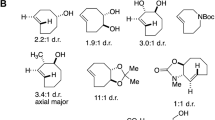Abstract
The synthesis of a series of 2-(10,11-dihydrodibenz(b,f)azepinyl)carbazole-based monomers is reported. Full characterization of their structures is presented. The monomers were subjected to cationic polymerization using BF3·O(C2H5)2 as an initiator. The synthesized monomers and polymers were examined by differential scanning calorimetry, UV spectrometry, cyclic voltammetry and electron photoemission spectrometry. The electrochemical investigation of the solutions of the synthesized compounds revealed HOMO values ranging from −5.12 to −5.06 eV. Electron photoemission spectrometry of the solid samples gave ionization potentials of 5.40–5.50 eV.





Similar content being viewed by others
References
Morin JF, Leclerc M, Ades D, Siove A (2005) Polycarbazoles: 25 years of progress. Macromol Rapid Commun 26:761–778
Grazulevicius JV, Strohriegl P, Pielichowski J, Pielichowski K (2003) Carbazole-containing polymers: synthesis, properties and applications. Prog Polym Sci 28:1297–1353
Thomas KRJ, Lin JT, Tao YT, Ko CW (2001) Light-emitting carbazole derivatives: Potential electroluminescent materials. J Am Chem Soc 123:9404–9411
Niu YH, Huang J, Cao Y (2003) High-efficiency polymer light-emitting diodes with stable saturated red emission: use of carbazole-based copolymer blends in a poly(p-phenylenevinylene) derivative. Adv Mater 15:807–811
Aich R, Ratier B, Tran-Van F, Goubard F, Chevrot C (2008) Hydrazone based molecular glasses for solid-state dye-sensitized solar cells. Thin Solid Films 516:7171–7175
Shen JY, Yang XL, Huang TH, Lin JT, Ke TH, Chen LY, Wu CC, Yeh MCP (2007) Ambipolar conductive 2,7-carbazole derivatives for electroluminescent devices. Adv Funct Mater 17:983–995
Park SH, Roy A, Beaupre S, Cho S, Coates N, Moon JS, Moses D, Leclerc M, Lee K, Heeger AJ (2009) Bulk heterojunction solar cells with internal quantum efficiency approaching 100%. Nat Photonics 3:U5–297
Drolet N, Morin JF, Leclerc N, Wakim S, Tao Y, Leclerc M (2005) 2,7-carbazolenevinylene-based oligomer thin-film transistors: high mobility through structural ordering. Adv Funct Mater 15:1671–1682
Chang CC, Wu JY, Chien CW, Wu WS, Liu H, Kang CC, Yu LJ, Chang TC (2003) A fluorescent carbazole derivative: high sensitivity for quadruplex DNA. Anal Chem 75:6177–6183
Grazulevicius JV (2006) Charge-transporting polymers and molecular glasses for optoelectronic applications. Polym Adv Technol 17:694–696
Simokaitiene J, Grigalevicius S, Grazulevicius JV, Rutkaite R, Kazlauskas K, Jursenas S, Jankauskas V, Sidaravicius J (2006) Synthesis, photophysical and photoelectrical properties of glass-forming phenothiazinyl- and carbazolyl-substituted ethylenes. J Optoelectron Adv Mater 8:876–882
Morin JF, Leclerc M (2001) Syntheses of conjugated polymers derived from N-alkyl-2,7-carbazoles. Macromolecules 34:4680–4682
Morin JF, Boudreault PL, Leclerc M (2002) Blue-light-emitting conjugated polymers derived from 2,7-carbazoles. Macromol Rapid Commun 23:1032–1036
Dierschke F, Grimsdale AC, Müllen K (2003) Efficient synthesis of 2,7-dibromocarbazoles as components for electroactive materials. Synthesis 16:2470–2472
Patil SA, Scherf U, Kadashchuk A (2003) New conjugated ladder polymer containing carbazole moieties. Adv Funct Mater 13:609–614
Sonntag M, Strohriegel P (2004) Novel 2,7-linked carbazole trimers as model compounds for conjugated carbazole polymers. Chem Mater 16:4736–4742
Paliulis O, Ostrauskaite J, Gaidelis V, Jankauskas V, Strohriegl P (2003) Synthesis of conjugated carbazole trimers and pentamers by Suzuki coupling. Macromol Chem Phys 204:1706–1712
Blouin N, Leclerc M (2008) Poly(2,7-carbazole)s: structure–property relationships. Acc Chem Res 41:1110–1119
Boudreault PLT, Blouin N, Leclerc M (2008) Poly(2,7-carbazole)s and related polymers. Adv Polym Sci 212:99–124
Wakim S, Aïch BR, Tao Y, Leclerc M (2008) Charge transport, photovoltaic, and thermoelectric properties of poly(2,7-carbazole) and poly(indolo[3,2-b]carbazole) derivatives. Polym Rev 48:432–462
Tomkeviciene A, Bartiuk T, Grazulevicius JV, Jankauskas V (2011) Monomers and polymers with the pendent adducts of carbazole with 5H-dibenz(b, f)azepine and its 10,11-dihydro derivative. React Funct Polym 71:796–802
Kirkus M, Lygaitis R, Tsai MH, Grazulevicius JV, Wu CC (2008) Triindolylmethane-based high triplet energy glass-forming electroactive molecular materials. Synth Met 158:226–232
Lygaitis R, Grazulevicius JV, Gaidelis V, Jankauskas V, Sidaravicius J, Tokarski Z, Jubran N (2005) Hole-transporting glass-forming 3,3′-dicarbazyl-based hydrazones. Mol Cryst Liq Cryst 427:407–418
Miyamoto E, Yamaguchi Y, Yokoyama M (1989) Ionization potential of organic pigment film by atmospheric photoelectron emission analysis. Electrophotography 28:364–370
Lux M, Strohriegl P, Hoecker H (1987) Polymers with pendant carbazolyl groups. Macromol Chem 188:811–820
Sonntag M, Kreger K, Hanft D, Strohriegl P, Setayesh S, Leeuw D (2005) Novel star-shaped triphenylamine-based molecular glasses and their use in OFETs. Chem Mater 17:3031–3039
Sangermano M, Malucelli G, Morel F, Decker C, Priola A (1999) Cationic photopolymerization of vinyl ether systems: influence of the presence of hydrogen donor additives. Eur Polym J 35:639–645
Lengvinaite S, Grigalevicius S, Grazulevicius JV, Getautis V, Sangermano M, Malucelli G, Priola A (2009) Synthesis and cross-linking of bifunctional monomers containing carbazole moieties. React Funct Polym 69:325–329
Odian G (2004) Principles of polymerization. Wiley-VCH, Weinheim
Tomkeviciene A, Grazulevicius JV, Kazlauskas K, Gruodis A, Jursenas S, Ke TH, Wu CC (2011) Impact of linking topology on the properties of carbazole trimers and dimers. J Phys Chem C 115:4887–4897
Thelakkat M, Ostrauskaite J, Leopold A, Bausinger R, Haarer D (2002) Fast and stable photorefractive systems with compatible photoconductors and bifunctional NLO-dyes. Chem Phys 285:133–147
Oda Y, Homma T, Fujimaki Y (1990) Near-infrared sensitive photoreceptors incorporating a new polymorph of oxotitanium phthalocyanine. Electrophotography 29:250–258
Chigono Y, Kitamura T (1993) photoinduced discharge of organic photoreceptor with flash exposure. (III). The response to flash light for double layere organic photoreceptor. Electrophotography 32:7–12
Nakazawa T, Kawahara A, Mizuta Y, Miyamoto E (1994) Photoconduction mechanism for monolayer organic photoreceptor for positive charging xerography using perylene pigment. Electrophotography 33:127–134
Aoki D, Kashiwabara M, Okabe M, Hikosaka S, Inoe E (2000) Organic photosensor in elgraphy (II): photoinduced current amplifying layer. J Imag Sci Technol 44:179–187
Hartnagel HL, Dawar AL, Jain AK, Jagadish C (1995) Semiconducting transparent thin films. IOP, Bristol
Acknowledgments
This research was funded by a grant (No. MIP-059/2011) from the Research Council of Lithuania. A. Tomkeviciene acknowledges EU structural Funds project “Postdoctoral Fellowship Implementation in Lithuania” for funding her postdoctoral fellowship. We thank habil. Dr. V. Gaidelis for the help in ionization potential measurements.
Author information
Authors and Affiliations
Corresponding author
Rights and permissions
About this article
Cite this article
Tomkeviciene, A., Bartiuk, T. & Grazulevicius, J.V. Synthesis and properties of 2-(10,11-dihydrodibenz[b,f]azepine-5-yl)carbazole-based monomers and polymers. Polym. Bull. 68, 453–464 (2012). https://doi.org/10.1007/s00289-011-0564-2
Received:
Revised:
Accepted:
Published:
Issue Date:
DOI: https://doi.org/10.1007/s00289-011-0564-2




